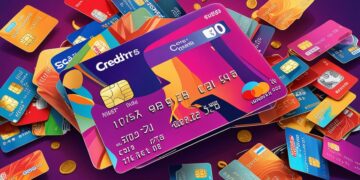Tips to Avoid Credit Card Debt: A Practical Guide

Understanding Credit Card Debt
Credit card debt affects a significant portion of American consumers, posing challenges not only to their finances but also to their overall well-being. The staggering statistic that the average American household carries around $8,400 in credit card debt underscores the weight of this issue. As interest rates can vary significantly—often ranging from 15% to over 25%—the burden of repayment quickly escalates, creating a vicious cycle of borrowing and interest accumulation.
Common Triggers of Credit Card Debt
Several factors contribute to individuals falling into the abyss of credit card debt. Understanding these can empower consumers to make informed choices.
- Impulse purchases: The convenience of credit cards makes it too easy to make unplanned purchases. Many consumers make decisions based on momentary desire rather than necessity, contributing to debt accumulation.
- High interest rates: With substantial interest rates, particularly for those with less-than-stellar credit, the monthly payments can quickly soar. This can lead to the unfortunate scenario where only a fraction of each payment goes toward reducing the principal debt.
- Unexpected expenses: Emergencies such as medical bills or car repairs can arise without warning, often resulting in reliance on credit to cover these unforeseen costs. This can push individuals deeper into debt if they lack an emergency fund.
Proactive Financial Management
Adopting a practical approach can significantly reduce the risk of falling into credit card debt. Here are some actionable strategies:
- Establishing a realistic budget: By tracking income and expenditures, individuals can identify spending patterns and cut unnecessary expenses, allowing for mindful purchases and reduced reliance on credit.
- Choosing the right credit card with favorable terms: Researching and comparing credit card options can lead to selecting a card with lower interest rates, fewer fees, and beneficial rewards. For instance, some cards offer cashback on purchases, which can mitigate the overall cost of borrowing.
- Implementing strategies for timely payments: Setting up automatic payments and reminders can help ensure bills are paid on time, thereby avoiding late fees and additional interest that could compound debt.
Taking these steps not only fosters effective credit management but also helps build a robust financial foundation for the future. By remaining aware of spending habits and understanding the implications of credit use, individuals can cultivate healthier financial practices, ultimately leading to reduced debt levels and improved financial stability.
Proactive Financial Management Strategies
One of the most effective ways to avert credit card debt is through proactive financial management. By implementing intentional financial practices, consumers can not only avoid detrimental debt trends but also foster a healthier relationship with credit. The following strategies offer a foundation for sound financial practices.
Establishing a Realistic Budget
Creating a budget is arguably the cornerstone of effective financial management. A well-structured budget involves tracking all sources of income along with detailed records of expenditures. This approach fosters increased awareness of where money goes and can reveal patterns of spending that may not align with financial goals. Studies indicate that individuals who maintain a budget are more likely to save effectively and avoid unnecessary debts.
- Identify fixed and variable expenses: Fixed expenses include regular bills such as rent or mortgage payments, while variable expenses can fluctuate monthly. Understanding these categories allows consumers to prioritize their spending.
- Allocate funds for savings: Setting aside a designated amount for savings each month can create a safety net for unexpected expenses, minimizing the need to rely on credit cards during emergencies.
- Review and adjust regularly: A budget should not be static. Periodically reviewing and adjusting one’s budget based on changing income, lifestyle, or unforeseen circumstances is vital for ongoing financial health.
Choosing the Right Credit Card
Not all credit cards are created equal. Opting for a card with favorable terms can significantly impact how credit is managed and how debt accumulates. Consumers should look for credit card options with features that align with their spending habits and financial goals.
- Interest rates: Compare the annual percentage rates (APRs) of various credit cards. A lower APR means less interest accrues on balances carried over, enabling quicker repayment and less overall debt.
- Fees: Be mindful of annual fees, late payment fees, and foreign transaction fees. Selecting cards with minimal or no fees can save consumers money over time.
- Rewards programs: Some credit cards offer rewards such as cashback, points, or travel perks. Utilizing a card that matches spending habits can create value without fostering debt, as long as purchases are kept within budget.
Implementing Timely Payment Strategies
Failure to make timely payments can lead to late fees, increased interest rates, and decreasing credit scores—all contributing factors to escalating credit card debt. To combat this, it’s essential to develop reliable payment strategies.
- Set up automatic payments: Automating monthly payments ensures that bills are paid on time, minimizing late fees and interest charges.
- Use reminders: If automated payments aren’t feasible, setting up reminders via phone alerts or calendar notifications can be an effective alternative.
- Pay more than the minimum: Whenever possible, consumers should strive to pay more than the minimum payment due. This practice reduces principal balances faster, thereby decreasing the total interest paid over time.
By adopting these practical strategies, individuals can cultivate effective financial habits that deter credit card debt, paving the way for greater financial stability and security in the long run. Through diligent planning and conscious spending, the opportunity to maintain a debt-free lifestyle becomes increasingly attainable.
Mindful Spending Practices
In addition to budget planning and timely payment strategies, adopting mindful spending practices is critical for avoiding credit card debt. By cultivating an awareness of purchasing habits and making informed decisions, consumers can significantly decrease the likelihood of falling into a debt trap.
Creating a “Needs vs. Wants” Framework
Classifying purchases into “needs” and “wants” can provide clarity in spending. Needs are essentials such as housing, food, and healthcare, while wants are non-essential items or experiences. Adopting this framework aids consumers in making decisions that prioritize essential expenditures.
- Conduct regular assessments: Before making a purchase, assess whether the item is a necessity. This can curtail impulsive buying behaviors that inflate credit card balances.
- Practice the 24-hour rule: For non-essential purchases, wait 24 hours before buying. This pause gives individuals time to reconsider whether the purchase aligns with their financial goals.
Exploring Alternative Payment Methods
Relying solely on credit cards can create dependency and encourage overspending. Exploring alternative payment methods can empower consumers to manage their finances better and avoid accruing debt.
- Use debit cards: Debit cards withdraw funds directly from a checking account, which can help manage spending more effectively as it limits purchases to available funds.
- Utilize cash: Adopting a cash-only approach for discretionary spending can foster a tangible awareness of expenditures. When the cash runs out, spending stops.
- Consider prepaid cards: Prepaid cards work similarly to debit cards but allow for additional budgeting flexibility by loading them with a predetermined amount. This mechanism provides a controlled environment for spending.
Leveraging Financial Tools and Resources
The digital age provides access to a plethora of financial tools designed to enhance spending awareness and budgeting. Capitalizing on these resources can empower individuals to take control of their financial destinies.
- Budgeting apps: Free and paid apps like Mint, YNAB (You Need A Budget), and Personal Capital provide intuitive platforms for tracking spending and setting budgets in real-time.
- Spending alerts: Many banks and credit card companies offer spending alerts that notify users when they approach limits set in their budgets, helping to further curtail unnecessary expenditures.
- Financial literacy courses: Taking advantage of community-based programs or online courses can significantly enhance financial literacy, equipping consumers with the knowledge to make informed spending decisions.
Incorporating mindful spending practices into day-to-day life can yield substantial benefits, both in the short and long term. Understanding the difference between wants and needs, exploring alternative payment methods, and leveraging financial tools can help individuals make strategic decisions that align with their financial goals. Collectively, these strategies can create a sustainable spending behavior that mitigates the risks associated with credit card debt.
Conclusion
In today’s fast-paced financial landscape, accumulating credit card debt can happen more easily than one might expect. However, by implementing proactive strategies and maintaining disciplined spending habits, individuals can markedly reduce their risk of falling into this common pitfall. The key takeaway from this guide is the importance of cultivating a robust financial framework tailored to one’s personal circumstances.
Utilizing the “needs vs. wants” framework helps in prioritizing essential purchases, thereby effectively curbing impulsive expenditures. Furthermore, opting for alternative payment methods such as debit cards or cash fosters a sense of budgetary control, making spending more tangible. Emphasizing the significance of technology, leveraging financial tools and resources can enhance one’s ability to monitor and manage finances, reinforcing healthy money habits.
Ultimately, financial literacy plays a crucial role in this endeavor. Armed with a strong understanding of personal finance, consumers are better equipped to navigate the complexities of spending and debt management. Through consistent practice of the strategies outlined in this article, individuals can not only protect themselves from the dangers of credit card debt but also build a solid foundation for future financial stability and success. As financial stewardship requires ongoing diligence, it is essential to remain engaged and adaptable in one’s journey toward sound financial health.

James Carter is a financial writer and consultant with expertise in economics, personal finance, and investment strategies. With years of experience helping individuals and businesses navigate complex financial decisions, James provides practical insights and analysis. His goal is to empower readers with the knowledge they need to achieve financial success.





